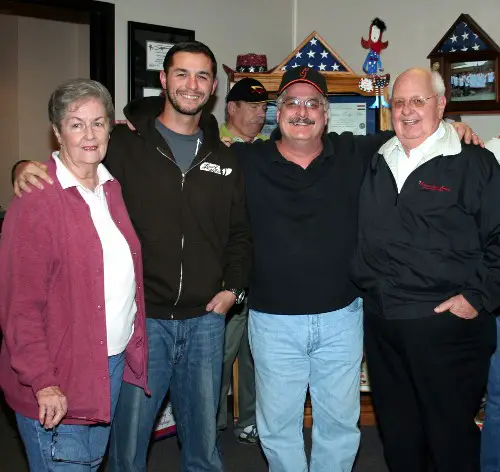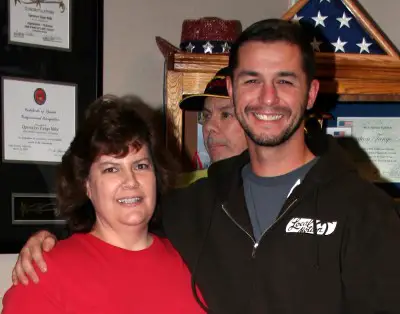LUCERNE – The company that owns Lucerne's water system says it believes its utility model works and that it's not interested in selling the company.
California Water Service Co. is asking the California Public Utilities Commission (CPUC) for rate hikes on its Lucerne system totaling nearly 68 percent over the coming three years, a decision that the commission currently is considering.
The CPUC held a public hearing at the Lucerne Alpine Senior Center March 4 about those suggested hikes, with Administrative Judge Jeffrey O'Donnell leading the hearing, as Lake County News has reported.
Community members raised a series of important points about the system's design, the cost for Lucerne's water compared to that of other areas in Cal Water's 24-district system and how the company can justify serious rate hikes in a community with high poverty and unemployment rates.
A report released last Wednesday placed Lake County's overall unemployment rate at 19.6 percent, and Lucerne's rate at 20.7 percent.
Statewide, California Water Service Group, Cal Water's parent company, has filed a general rate case for all of its districts, seeking rate increases of $70.6 million over the next three years.
On Feb. 24, California Water Service Group reported that its 2009 net income was up by $41 million or 2 percent over 2008. The company's revenues were up 10 percent, or $39 million, from 2008, growing to $449 million in 2009.
Of those revenues, an additional $50 million came from rate increases and $11 million in sales to new customers. At the same time, total operating expenses increased 11 percent or $38 million to $391 million in 2009, as costs for water production expense increased 9 percent, or $12 million, to $159 million compared to $147 million in 2008, the company reported.
At the same time, administrative and general expense increased 27 percent, or $16 million, to $75 million. The company reported that those costs were “primarily due to increased healthcare and benefit costs, new employees added as a result of our Hawaii acquisition, and new employees included in adopted rates for California.”
Other operations expense increased 11 percent, or $5 million, to $57 million, which company officials said are due primarily to increases in conservation expense and water treatment/water quality expense.
Since the March 4, Lake County News followed up with company to get additional information in response to questions that were posed but not answered. Lake County News also threw in a few of its own questions. Cal Water rates manager Darin Duncan provided the answers printed below.
The CPUC is still taking comments on Application No. 09-07-001 to the CPUC Public Advisor's Office, 505 Van Ness Ave., San Francisco, CA 94102; e-mail This email address is being protected from spambots. You need JavaScript enabled to view it. ; telephone 866-849-8390 or 415-703-2074.
The case also is on the CPUC Web site at www.cpuc.ca.gov/PUC/water .
Water rates comparisons
Question: At the March 4 meeting, Lucerne resident Dr. Wilson Goddard made comparisons between the rates in Cal Water's San Mateo district and in Lucerne, where meter charges are $8.75 and $32.58, respectively.
He also pointed out that San Mateo's charge for one “CCF” – or 100 cubic feet – of water is $3.03; for the same amount of water, Lucerne customers pay $5.45, and San Mateo's median income, based on the 2000 US Census, is $95,750, versus Lucerne's $25,345.
At the meeting Duncan explained the costs for getting the water from San Mateo, but he didn't explain the costs involved with Lucerne, such as who Cal Water purchases water from, how much it costs and the comparable monetary investment for treatment. He was asked to provide that information.
Answer: The water for Lucerne comes from Clear Lake. Cal Water must purchase this water from the Yolo County Flood Control & Water Conservation District at a current cost of $52.50 per acre foot of water or $2.10 per CCF. The total cost to purchase and treat the water, Duncan said, is $915 an acre foot.
“This is untreated water that Cal Water then pumps out of the lake and through the treatment plant. It costs approximately $2.10 per CCF to treat the water through the Lucerne plant,” he said.
That's compared to San Mateo, where their water cost from the San Francisco Public Utilities Commission is $1.65 per CCF or $718 per acre foot. That water already is treated.
“The main point of difference with the San Mateo system and the Lucerne system is that San Mateo is an urban area with 35,000 services versus only 1,280 customers for Lucerne,” Duncan wrote in his response. “There are large economies of scales in the water industry and individual water system components cost about the same in all areas.
“However, if we invest in say a $100,000 water main in Lucerne, this costs each customer approximately $12 per year, while that same $100,000 pipeline installed in San Mateo is spread over a much larger base and costs each of those customers less than $0.50 per year,” Duncan said.
What did the company pay for the Lucerne water system?
Questions: The company was asked on March 4 about the amount of money that Dominguez Service Corp. – which later merged with Cal Water – paid for the system when it purchased it from Bob and Nadine Strauss in 1999.
Lake County News also asked about any current agreements the company has with the Strausses, who several years ago built a large home on the lakefront next door to the location where the new treatment plant, completed last year, is located.
Answers: Dominguez Service Corp. paid $729,586 in 1999 for the Lucerne Water Co. Subsequent to that purchase, Cal Water and Dominquez Service Corp. merged, Duncan said.
“The only current agreement in effect with the Strausses is a mutually beneficial easement at the treatment plant site that allows the Strausses to access their property across part of our property and allows Cal Water to access our property across part of the Strauss property,” Duncan added.
Justification for rate hikes
Questions: Many Lucerne residents at the March 4 hearing discussed their dire economic straits, and their fears about having to choose between paying their water bills and buying food.
Cal Water was asked about its justification for asking for such high rate hikes in a community like Lucerne, which is one of the poorest in a county that has one of the state's highest unemployment rates.
They were asked why they are seeking approximately 68.5 percent in rate hikes for Lucerne over the coming three years. Statewide, the increases they're seeking over that same three-year period average 26.58 percent for all districts statewide.
In addition, they were asked about options for lower middle class and middle class residents who can't pay their bills but don't qualify for rate support.
Answers: Duncan explained that, in accordance with the CPUC, Cal Water calculates the cost of providing service to each district independently.
“We review what capital improvements are needed to keep the system operating to meet all Department of Public Health (DPH) standards and this is a large factor in the requested rate increase. When improvements are required to meet DPH standards, Cal Water does not look at the unemployment rate or social-economic background. The commission has consistently ruled that all customers have a right to safe, reliable service regardless of these factors. Rather, we comply with water quality regulations to ensure that our customers are drinking safe water that meets all applicable standards. This can be a difficult concept for people to understand, especially when the improvements are due to changes in regulations and people have been drinking the water under the old regulations for a long time with no perceived health effects.”
Unlike the electricity industry, Duncan said the CPUC requires that all tariff areas have independent costs of service. However, in 2005 the CPUC approved a rate support fund that reduces Lucerne customer bills by $17 per month (paid for by other Cal Water ratepayers). Cal Water has proposed increasing this subsidy in this application to $25.
“If customers fall behind on payments, we will work with them to set up payment plans,” Duncan wrote. “We also offer conservation devices to help educate customers about possibilities to save water and lower their monthly bills. Ultimately, if a customer fails to pay their water bills, we are forced to discontinue service to the customer in compliance with CPUC rules.”
Impacts on redevelopment efforts and community renovation
Question: At the March 4 hearing, District 1 Supervisor Denise Rushing and county Deputy Redevelopment Director Eric Seely both voiced concerns about the rate hikes.
In particular, Seely communicated the county's concerns regarding how the water rates are hampering the agency's ability to draw new businesses to the area. County officials also out that the county is itself a system customer, with its Lucerne facilities and parks supplied by the system.
Duncan was asked about what, if anything, has come of the company's discussions with the Lake County Redevelopment Agency.
Answer: Cal Water's discussions with Seely and the Lake County Redevelopment Agency “have not been generalized to the topic of the economy of the area,” Duncan wrote.
“Our contact has been very specific to individual projects where the water system may be impacted,” he continued. “They have requested location of underground facilities and they have provided plans for sidewalk improvements. The Parks Department has a service and they have tried to keep costs down by only maintaining one service, instead of using three separate old services by installing on-site piping to allow them to use only one service. We plan to work more closely with this agency to ensure we are doing all we can to help this situation.”
The system's conditions and Cal Water's knowledge of it at purchase
Question: Lucerne residents raised the issue on March 4 of what Dominguez and, subsequently Cal Water, knew about the Lucerne water system's condition at the time of purchase. Was any due diligence done to understand the condition of the system?
Answer: “Cal Water and Dominguez both conducted due diligence on the Lucerne system,” Duncan explained. “Both corporations realized that significant improvements were required to the treatment system and to the distribution system.
“I believe these improvements were envisioned to be farther out on the horizon, but changes to water quality standards affected the need to make these improvements sooner than anticipated in any due diligence,” he wrote. “The CPUC has recognized that smaller water companies are unable to perform the technical upgrades needed to meet changing regulation and they have encouraged more stable companies like Cal Water to acquire these smaller companies. The CPUC does not have a different model on how to calculate water rates for these smaller systems and is generally in favor of Cal Water making these improvements.”
Willingness to contemplate no profits?
Question: Are the company and its shareholders willing to contemplate that they may have to accept no profits from the Lucerne system in the coming several years?
Answer: The answer, said Duncan, is no.
“This is contrary to CPUC policy,” he wrote.
“In order for the utility to make investments that provide service to customers, the CPUC allows the utility reasonable costs of financing. Apart from cost of financing, Cal Water does not make any profit from its operations. The company is committed to only providing improvements necessary to meet DPH requirements and will work with the commission to identify the minimum required projects. Once again, Cal Water is seeking to increase the Lucerne subsidy from its other customers to offset some of the high cost of service in the area.”
A proposal for local ownership and control
Question: In response to Cal Water's 2005 proposal for a 246-percent increase for the Lucerne district, two local groups – Lucerne Community Water Organization (LCWO) and Lucerne Friends of Locally Owned Water (LucerneFLOW) arose to help fight request. The company ended up getting a roughly 120-percent increase, with low-income relief measures also adopted.
Community advocates have proposed to seek a purchase of the water system, either under their own steam or through the assistance of local government.
Would Cal Water contemplate selling the company to the county or the Lucerne community?
Answer: “No, Cal Water is not interested in selling the Lucerne district,” Duncan wrote.
“We believe we have a utility model that works and we are proud of the improvements we have made to the system,” he explained. “We would be interested in growing our presence in Clear Lake in order to spread fixed costs over a larger base and lower average costs.
“However, all parties including Cal Water need to understand that water service for this local area is expensive and will remain expensive for the foreseeable future regardless of system ownership, unless some outside entity pays the costs,” he concluded.
Question: In followup to his statement about an outside entity, Lake County News asked if Duncan was suggesting a state or county agency needed to assist with funding to pay for the system.
Answer: Duncan said the funding could be from different sources, such as improvements from developers or changes to the rate support fund structure.
Duncan said that, as Cal Water representatives noted at the March hearing, federal stimulus money is not available to Cal Water, but stimulus money has funded some of the state revolving loan funds.
“In some cases, public agencies pay for some of the infrastructure and Cal Water does not earn a return on this contributed infrastructure,” he wrote. “I realize at this time, this is not feasible, but in the future we plan to look at all options.”
E-mail Elizabeth Larson at This email address is being protected from spambots. You need JavaScript enabled to view it. . Follow Lake County News on Twitter at http://twitter.com/LakeCoNews and on Facebook at http://www.facebook.com/pages/Lake-County-News/143156775604?ref=mf .

 How to resolve AdBlock issue?
How to resolve AdBlock issue? 










